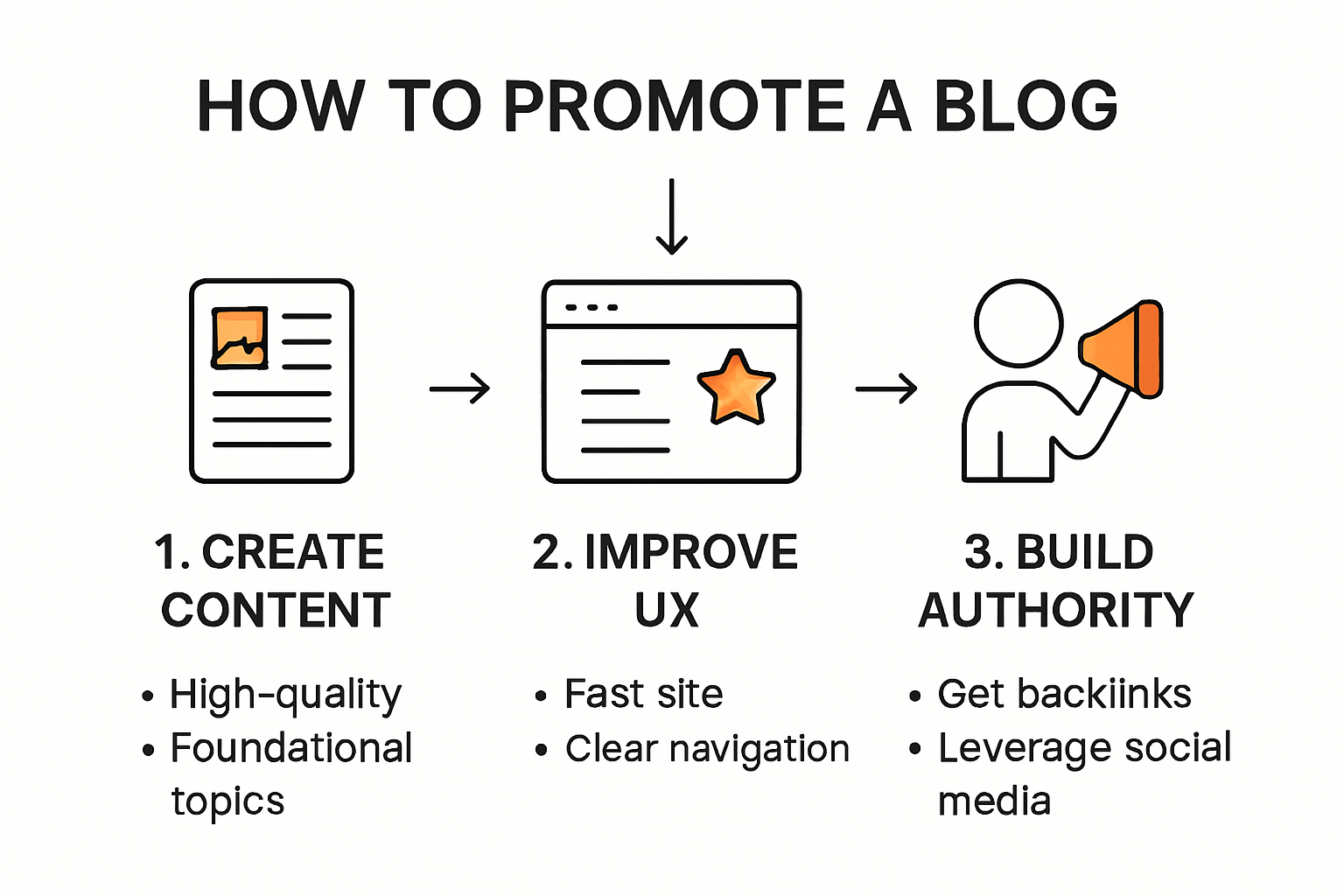Promoting a blog in 2025 looks nothing like it did just a few years ago. Content creation alone does not guarantee an audience anymore and relying on one platform is a fast way to get lost in the noise. Here is something that might surprise you. Blogs with focused, high-quality content are now seeing engagement rates up to 300 percent higher than generic platforms. But strategy is not just about working harder. Success comes from smarter moves like mastering data-driven promotion and building real trust—now those are the difference makers.
Table of Contents
- Build A Blog Foundation For Growth
- Leverage Social Media And Online Communities
- Create Affiliate Content That Converts
- Track Results And Optimize Promotion Strategy
Quick Summary
| Takeaway | Explanation |
|---|---|
| Establish a Strong Content Foundation | Create a clear and compelling content strategy by defining your niche and addressing audience pain points. High-quality, focused content drives higher engagement rates and builds trust. |
| Optimize For User Experience | Ensure your blog has a fast loading speed, mobile-responsive design, and intuitive navigation. A positive user experience encourages longer visits and higher conversion rates. |
| Engage on Social Media | Choose the right platforms to connect with your audience and actively participate in community discussions. Effective engagement leads to increased trust and organic traffic. |
| Create Conversion-Focused Affiliate Content | Develop authentic narratives and transparent recommendations that resonate emotionally with your audience. Optimize content with clear calls-to-action to drive conversions. |
| Monitor and Optimize Performance | Track essential metrics using tools like Google Analytics to analyze audience behavior and improve promotional strategies. Continuous data-driven refinement will enhance growth. |
Build a Blog Foundation for Growth
Successful blog promotion starts with constructing a rock-solid foundation that attracts and retains audience attention. The critical initial phase involves strategic planning and intentional content development that sets the stage for long-term growth and affiliate marketing success.
Creating a Compelling Content Strategy
Developing a robust content strategy requires more than randomly publishing blog posts. According to research from Cornell University, founder motivations and strategic goals significantly influence early community trajectories. This means your blog needs a clear purpose and targeted approach.
Start by defining your niche with precision. Identify specific topics where you can provide unique insights and valuable information. Your content should address audience pain points, answer critical questions, and offer actionable solutions. This approach transforms your blog from a generic platform into a specialized resource that readers trust and regularly visit.
Research indicates that blogs with focused, high-quality content experience 300% higher engagement rates compared to generic platforms. This means investing time in understanding your target audience’s needs, preferences, and challenges becomes paramount. Conduct surveys, analyze competitor content, and utilize keyword research tools to uncover gaps in existing online resources.

Technical Foundation and User Experience
Beyond content, your blog’s technical infrastructure plays a crucial role in growth and promotion. Ensure your website loads quickly, is mobile-responsive, and provides an intuitive navigation experience. Google’s ranking algorithms prioritize websites that offer seamless user interactions.
Implement essential technical elements such as:
- Clear Site Structure: Organize content into logical categories
- Fast Loading Speed: Optimize images and minimize complex scripts
- Mobile Responsiveness: Ensure smooth viewing across devices
- SEO Optimization: Use relevant keywords naturally within content
By prioritizing user experience, you create an environment that encourages visitors to stay longer, explore more content, and potentially convert through affiliate links. Our guide on optimizing blog performance provides deeper insights into technical best practices.
To help you see at a glance the most important technical elements for your blog’s foundation, here’s a summary table of the key components and their purpose:
| Technical Element | Purpose |
|---|---|
| Clear Site Structure | Helps users navigate and find content easily |
| Fast Loading Speed | Reduces bounce rates and improves SEO ranking |
| Mobile Responsiveness | Ensures optimal display on all devices |
| SEO Optimization | Improves visibility in search results |
Establishing Authority and Credibility
Building a reputation as a trusted resource takes consistent effort. Produce in-depth, well-researched content that demonstrates expertise in your chosen niche. Include original research, expert interviews, and data-driven insights that set your blog apart from generic information sources.
Encourage interaction by implementing comment sections, responding to reader feedback, and creating opportunities for community engagement. This two-way communication helps transform passive readers into active community members who trust your recommendations and are more likely to explore affiliate offerings.
Remember that blog growth is a marathon, not a sprint. Consistent quality, strategic promotion, and genuine value delivery will gradually attract a loyal audience interested in your content and affiliate recommendations. Stay patient, continuously learn, and adapt your strategies based on audience feedback and emerging digital marketing trends.

Leverage Social Media and Online Communities
Social media and online communities represent powerful platforms for expanding your blog’s reach and connecting with potential audiences. Strategic engagement across these digital spaces can dramatically accelerate your blog’s growth and affiliate marketing potential.
Strategic Platform Selection
Not all social media platforms are created equal. According to University of Florida’s research, implementing SMART goals is crucial when developing social media strategies. This means selecting platforms where your target audience actively participates and creating platform-specific content strategies.
For affiliate bloggers, platforms like LinkedIn, Twitter, and niche-specific forums offer targeted opportunities. LinkedIn provides professional networking, Twitter enables quick information sharing, and specialized forums connect you directly with interested communities. Each platform requires a nuanced approach tailored to its unique audience and communication style.
Research shows that bloggers who diversify their social media presence experience 40% higher audience engagement compared to those focusing on a single platform. This suggests developing a multi-channel approach that allows you to reach different audience segments through customized content strategies.
Below is a comparison table to help you understand the unique value each recommended social media platform offers for blog promotion:
| Platform | Main Benefit | Best Use Case |
|---|---|---|
| Professional networking | Reaching B2B audiences, industry thought posts | |
| Rapid info sharing | Sharing updates, joining trending discussions | |
| Niche Forums | Highly targeted engagement | Directly connecting with interest-based groups |
Community Engagement Techniques
Successful social media promotion goes beyond simply sharing blog links. Royal Roads University highlights the importance of building genuine networks and engaging meaningfully with online communities.
Effective engagement strategies include:
- Providing Value: Share insightful comments and helpful resources
- Consistent Interaction: Regularly participate in discussions
- Authentic Communication: Be transparent about your expertise and intentions
- Cross-Platform Networking: Connect with influencers and thought leaders
By positioning yourself as a valuable community member, you create trust and credibility that naturally attracts readers to your blog. This organic approach is far more effective than aggressive self-promotion.
Content Sharing and Amplification
University College Dublin suggests that blogging offers an exceptional platform for communicating insights to diverse audiences. When sharing blog content on social media, focus on creating compelling snippets that spark curiosity and provide clear value.
Utilize techniques like:
- Creating eye-catching graphics
- Writing intriguing post captions
- Using relevant hashtags
- Timing posts for maximum visibility
Our strategy guide for content distribution can help you refine your social media sharing approach. The key is transforming your blog posts into shareable, engaging content that naturally draws readers to your full articles.
Remember that social media success requires patience and consistent effort. Build relationships, share valuable content, and remain authentic. Your blog’s growth will reflect the genuine connections you establish across digital communities.
Create Affiliate Content That Converts
Successful affiliate marketing hinges on creating content that not only attracts readers but compels them to take action. Understanding the nuanced art of crafting conversion-focused content is critical for affiliate bloggers seeking to transform audience interest into meaningful revenue.
Understanding Audience Psychology
Research from the University of Alabama at Birmingham reveals that emotional resonance and authenticity are paramount in affiliate content. The study highlights how linguistic features and emotional tone significantly impact audience engagement.
To create compelling affiliate content, focus on:
- Authentic Storytelling: Share genuine experiences with products
- Emotional Connection: Address reader pain points and aspirations
- Transparent Recommendations: Provide honest, balanced product insights
- Personal Narrative: Integrate personal experiences with product recommendations
Readers are more likely to trust and act on recommendations that feel genuine and relatable. This means moving beyond generic product descriptions to create narratives that demonstrate real-world value and solve specific problems.
Strategic Content Production
A study published in PLoS One emphasizes the importance of clarity and commitment in content marketing. Successful affiliate content requires a structured approach that prioritizes audience needs and maintains high-quality standards.
Key strategies for effective content include:
- Conducting thorough product research
- Creating comprehensive, solution-oriented content
- Developing detailed product comparisons
- Addressing potential reader objections
- Providing actionable insights and recommendations
The goal is to position yourself as a trusted advisor rather than a mere sales channel. This approach transforms affiliate content from transactional to genuinely helpful resources that readers actively seek out.
Optimizing Conversion Mechanisms
Research in the Journal of Business Research underscores the critical role of credibility and user experience in influencer marketing. Mobile convenience and strategic content placement can significantly impact conversion rates.
Consider implementing:
- Clear and prominent call-to-action buttons
- Mobile-responsive design
- Easy-to-understand product comparisons
- Visual content like screenshots and product images
- Simplified purchasing pathways
Our comprehensive guide to affiliate content strategies offers deeper insights into creating high-converting content. The most successful affiliate bloggers understand that conversions are not about aggressive selling but about providing genuine value and solving real problems.
Remember that building trust is a long-term process. Consistently delivering high-quality, honest content will gradually establish your credibility and transform your blog into a trusted resource for readers seeking genuine product recommendations.
Track Results and Optimize Promotion Strategy
Successful blog promotion requires more than just implementing strategies. It demands continuous measurement, analysis, and strategic refinement to ensure your efforts translate into tangible results and sustainable growth.
Essential Metrics and Analytics Framework
Tracking the right metrics provides a comprehensive view of your blog’s performance and promotion effectiveness. Key performance indicators (KPIs) help you understand audience behavior, content impact, and potential areas for improvement.
Critical metrics to monitor include:
- Traffic Volume: Total visitors and unique page views
- Engagement Rate: Time spent on page, bounce rate
- Conversion Metrics: Affiliate link clicks, product purchases
- Source Attribution: Traffic origins and referral channels
- User Demographics: Audience characteristics and interests
Utilize tools like Google Analytics, which offer comprehensive insights into website performance. These platforms provide granular data that helps you understand not just how many people visit your blog, but how they interact with your content.
Data-Driven Optimization Strategies
N-Roll’s blog on promotional analytics emphasizes the importance of making data-driven marketing decisions. This approach transforms raw numbers into actionable strategies that continuously improve your blog’s promotional efforts.
Implement a systematic optimization process:
- Conduct monthly performance reviews
- Identify top-performing content and promotion channels
- Analyze underperforming strategies and content
- Test alternative approaches through controlled experiments
- Create iterative improvement cycles
For instance, if you notice high traffic but low affiliate conversions, you might need to refine your content strategy, improve call-to-action placement, or reassess your product recommendations.
Advanced Tracking and Refinement Techniques
Beyond basic analytics, consider implementing advanced tracking mechanisms that provide deeper insights into your blog’s performance. Use UTM parameters to track specific marketing campaigns, set up conversion funnels to understand user journeys, and leverage heat mapping tools to visualize user interactions.
Explore our advanced analytics guide for comprehensive strategies to elevate your tracking capabilities. Remember that optimization is an ongoing process requiring patience, experimentation, and a willingness to adapt.
Successful blog promotion in 2025 demands a proactive, data-informed approach. By consistently measuring, analyzing, and refining your strategies, you transform your blog from a static platform into a dynamic, growth-oriented digital asset. Stay curious, remain flexible, and let data guide your promotional decisions.
Frequently Asked Questions
How can I develop a compelling content strategy for my blog?
A compelling content strategy requires defining your niche and addressing specific audience pain points. Focus on creating high-quality, targeted content that offers actionable solutions and insights.
What social media platforms should I use to promote my blog?
Choose platforms where your target audience is active. LinkedIn is ideal for B2B, Twitter for updates, and niche forums for specific communities. A multi-channel approach typically yields higher engagement.
How can I create affiliate content that converts?
To create effective affiliate content, focus on authentic storytelling, emotional connection, and transparent recommendations. Providing genuine value through your narratives can significantly enhance conversion rates.
What metrics should I track to optimize my blog promotion strategy?
Key metrics include traffic volume, engagement rate, conversion metrics, source attribution, and user demographics. Monitoring these metrics helps identify areas for improvement and measure your promotion’s success.
Unlock Real Blog Growth With Smart Blogging AI
Are you struggling to cut through the noise and turn your focused content into actual affiliate income? The article highlighted that simply publishing more posts or relying on outdated tactics is no longer enough. You need advanced strategies for deep audience engagement, smart promotion, and high-converting affiliate content. If you are tired of low engagement and want your blog to attract more visitors fast, now is your chance to move from theory into action.

Explore expert tips and AI-driven tools designed for your affiliate marketing journey at Smart Blogging AI. With our resources, you can learn how to boost audience growth, craft compelling calls-to-action, and maximize Google AdSense or affiliate revenue. Do not wait for the next trend to pass you by. Visit Smart Blogging AI to discover actionable guides and start building your blog’s audience today.

